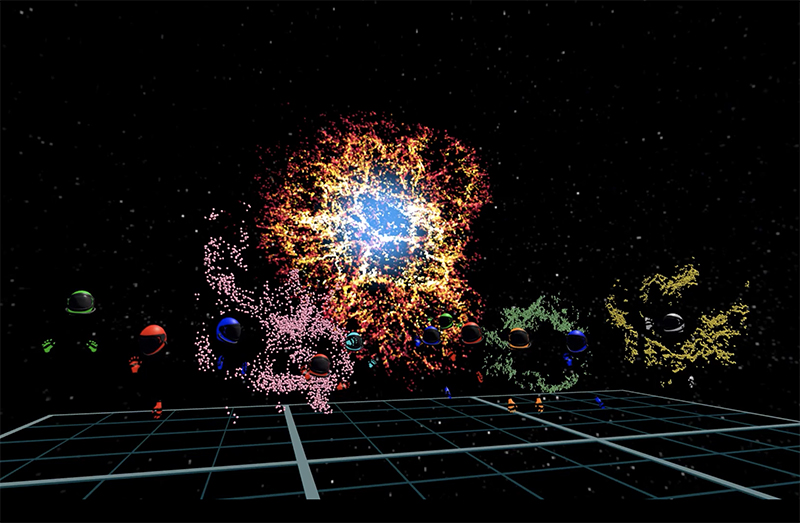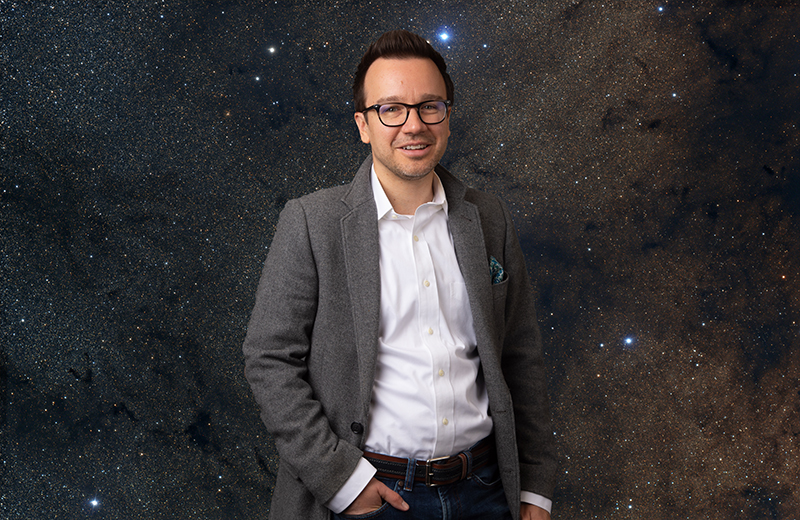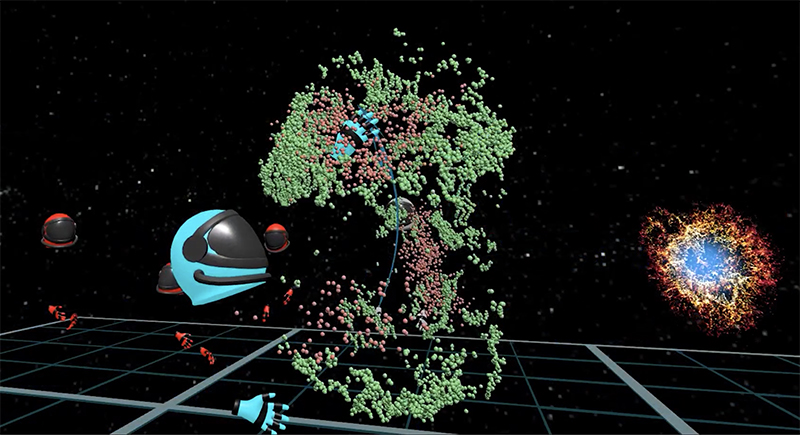May 3, 2021
Flying among the stars: Purdue University professor using virtual reality to teach astronomy
WEST LAFAYETTE, Ind. — A professor at Purdue University is teaching his students astronomy by letting them touch the stars. Danny Milisavljevic, assistant professor of physics and astronomy in the College of Science, is using innovative new technology for his students to use virtual reality headsets to explore space.
The first technology of its kind to allow connection by students in different locations — rather than on the same Wi-Fi network — the headsets are also based on lightweight, relatively inexpensive and commercially available hardware. The technology was used for the first time last month in his Intermediate Astronomy II class.
 A Purdue professor is using an innovative new technology to teach students in immersive environments—including stellar remnants thousands of light-years away. (Purdue University image)
Download image
A Purdue professor is using an innovative new technology to teach students in immersive environments—including stellar remnants thousands of light-years away. (Purdue University image)
Download image
The virtual reality environment allows students to fly through and around astronomical objects including stars and supernovae, and manipulate them to observe how they have changed over time, something that is possible thanks to enormous quantities of rich 3D modeling information and analyses. The system emphasizes scientific fidelity, giving a clear and accurate depiction of datasets. Similar systems eventually could allow students to study other topics including looking at microscopic or cellular data, anatomy, geospatial terrains, historical locations or even complex animated machinery. A video is available on YouTube.
Other companies and institutions have used virtual reality in a similar way before, but Milisavljevic’s solution is more scalable and less expensive — costing hundreds of dollars per unit rather than thousands — and drastically improves accessibility, allowing students to collaborate from anywhere on the globe with Wi-Fi.
 Milisavljevic, assistant professor of physics and astronomy, is pioneering new ways to teach students about distant astronomical objects. (Purdue University photo/Mark Simons)
Download image
Milisavljevic, assistant professor of physics and astronomy, is pioneering new ways to teach students about distant astronomical objects. (Purdue University photo/Mark Simons)
Download image
Milisavljevic already had built the virtual-reality platform, but with the onset of the pandemic, and concurrent mandates for socially distanced learning, he applied for an National Science Foundation RAPID Grant to help him develop this technology so that people did not have to be in the same physical location to share a virtual environment.
“I was awarded an instructional innovation grant as a learning aid,” Milisavljevic said. “We put on this headset, or even on a PC or Mac, and now we can all be in the same virtual environment. The instructors and students have great control over what we’re seeing, and we can collaborate to understand the stellar dynamics happening in distant galaxies and nebulae.”
The first test of the technology in a classroom environment was hugely successful, according to Milisavljevic, and he will continue to use it throughout the rest of the year. His students responded overwhelmingly positively.
 Innovative, lightweight, and accessible technology allows students to immerse themselves in astronomy, no matter where they are on Earth. (Purdue University image)
Download image
Innovative, lightweight, and accessible technology allows students to immerse themselves in astronomy, no matter where they are on Earth. (Purdue University image)
Download image
“This is the coolest thing I have done in a year!” wrote one student. “It’s just plain fun, and it’s super visually helpful for a subject like astronomy where things can be hard to visualize in 2D.”
“It was an awesome experience,” another wrote. “I felt as though I was actually walking around in space and the real-time manipulation of the stellar remnant renderings really added to the learning experience."
About the Envision Center
The Envision Center provides novel solutions to effectively communicate complex research concepts. Computer graphics, advanced visualization, auditory, haptic, and multimodal interaction integrate with state-of-the-art high-performance computation to assist researchers, instructors, and leaders in their quest for new knowledge and innovative products.
About College of Science
Purdue University's College of Science is committed to the persistent pursuit of the mathematical and scientific knowledge that forms the very foundation of innovation. Nearly 350 tenure-track faculty conduct world-changing research and deliver a transformative education to more than 1,200 graduate students and 4,300 undergraduates. The college is a community of learners that develops practical solutions to today's toughest challenges with degree programs in the life sciences, physical sciences, computational sciences, mathematics, and data science.
About Purdue University
Purdue University is a top public research institution developing practical solutions to today’s toughest challenges. Ranked the No. 5 Most Innovative University in the United States by U.S. News & World Report, Purdue delivers world-changing research and out-of-this-world discovery. Committed to hands-on and online, real-world learning, Purdue offers a transformative education to all. Committed to affordability and accessibility, Purdue has frozen tuition and most fees at 2012-13 levels, enabling more students than ever to graduate debt-free. See how Purdue never stops in the persistent pursuit of the next giant leap at https://purdue.edu/.
Writer, Media contact: Brittany Steff; 765-494-7833; bsteff@purdue.edu
Source: Dan Milisavljevic, dmilisav@purdue.edu
Journalists visiting campus: Journalists should follow Protect Purdue protocols and the following guidelines:
- Campus is open, but the number of people in spaces may be limited. We will be as accommodating as possible, but you may be asked to step out or report from another location.
- To enable access, particularly to campus buildings, we recommend you contact the Purdue News Service media contact listed on the release to let them know the nature of the visit and where you will be visiting. A News Service representative can facilitate safe access and may escort you on campus.
- Correctly wear face masks inside any campus building, and correctly wear face masks outdoors when social distancing of at least six feet is not possible.
Note to journalists: For a copy of the paper, please contact Brittany Steff, Purdue News Service, at bsteff@purdue.edu or 765-494-7833. A video and photos are available via Google Drive. Journalists visiting campus should follow visitor health guidelines.

